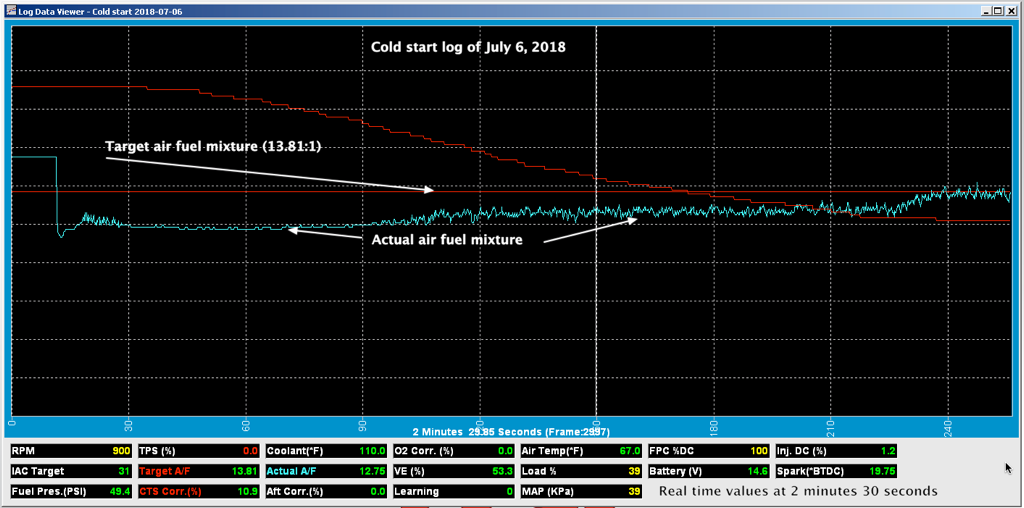Dear mid-60s Buick owners who are curious about high-tech,
Before heading out to fetch the groceries last Friday, I documented Biquette's cold start after modifying the warm-up fuel enrichment table to make the cold start less rich. The results were truly puzzling. To put things back into context, here is the video of the cold start I made on September 2, 2016.

Here is the video I took on Monday, June 26, 2018:

Finally, here is the video taken on Friday, July 6, 2018:

My reasons for relisting the previous two videos is to my disappointment that remains the ranking from smoothest idle to worst. Perhaps to help (or I fear confuse) here are the parameters that are in that warm-up fuel enrichment table at various stages of tuning the engine:
| Temperature | 4/26/16 | 9/2/16 | 7/6/18 |
| 0? F | 39.8 | 68.3 | 54.0 |
| 17? F | 39.1 | 67.1 | 53.1 |
| 34? F | 36.7 | 63.0 | 49.8 |
| 51? F | 32.0 | 54.9 | 43.5 |
| 68? F | 27.3 | 44.3 | 35.8 |
| 85? F | 20.3 | 30.9 | 25.6 |
| 102? F | 12.5 | 16.9 | 14.7 |
| 119? F | 7.0 | 9.4 | 8.2 |
| 136? F | 0.0 | 3.1 | 1.6 |
| 153? F | 0.0 | 0.0 | 0.0 |
| 170? F | 0.0 | 0.0 | 0.0 |
The first row after the coolant temperature values are the settings as Rich Nedbal had left them after he came by to tune the engine on April 26, 2016. As you can see, I had to enrich the warm up settings quite a bit by September. As I noted in the previous posting, what was almost spot on for the target air fuel mixture back then, is now significantly rich almost 2 years later. Here is the log from the cold start of July 6:

If you compare it to the log of June 26, it isn't very different. Even if the enrichment settings has been significantly reduced, the actual air fuel mixtures are very similar. When I view the last two videos, I'm tempted to go back to providing more fuel during the warm up since the engine was idling significantly better on June 26 than on July 6. However, when I compare all 3 videos, there is absolutely no doubt that the cold start of September 2, 2016 has the smoothest idle by far.
I arrived at the fuel enrichment values for my test of July 6 by taking the average between Rich's values and the values of September 2, 2016. Since I don't understand too clearly what is going on, I think I should once nudge the values further down by the same procedure. I need to determine whether or not the engine truly does idle best when the air fuel mixture is close to the final target after warm-up. Looks to me like I'll have to continue some trial and error to find out!
Cheers, Edouard
